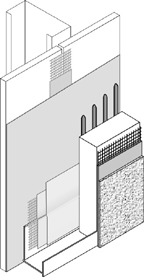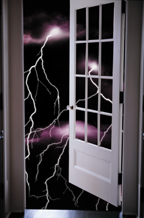

These seamless shields are said to be far more reliable than mechanically fastened felt paper in protecting sheathing and other wall components from air and water infiltration during normal service.
One EIFS manufacturer claims that its liquid weather barrier resists water penetration five times longer than leading brand house wraps and more than 28 times longer than conventional building paper.
Depending on the manufacturer, the new systems provide a redundancy in moisture protection and come with either cementitious or non-cementitious, acrylic-based membranes, according to Stephan E. Klamke, the Executive Director of the EIFS Industry Members Association.
Klamke suggests that the liquid-applied barrier can actually enhance the performance of EIFS when the latter is applied to wall surfaces with conventional adhesives.
Handle with care
EIFS manufacturers contend that liquid-applied weather barriers can be used with a wide variety of substrates, including plywood, OSB, gypsum and glass fiber-faced sheathings because of their ability to bridge sheathing joints and protect rough openings. In addition, manufacturers say the liquid-applied barriers:o Are seamless, with little risk of tearing or damage.
o Are water-based (not oil-based) and, therefore, environmentally friendly.
o Are easy to apply and to apply evenly.
o Reduce energy costs and increase interior comfort by reducing air leakage.
Despite their inherent advantages over traditional felt paper, the liquid-applied barriers have their limitations, Klamke cautions.
"Like building paper, they're not intended to correct faulty workmanship such as improper integration of flashing with cladding," he said. "Nor can they correct defective construction components such as windows that leak into the wall assembly."
Flashing is mandated by code, he adds, and should always be used to divert water to the exterior, not into the wall assembly, especially at potential moisture entry points such as windows.
Aside from protecting sheathing from incidental moisture, the liquid-applied barriers reduce the risk of condensation within the building envelope by preventing transfer of warm, moisture-laden interior air to the exterior. In cold climates, these barriers are especially effective in restricting the passage of moisture into the wall assembly, where it can condense.
Liquid-applied weather barriers should not be confused with vapor retarders, which may also be used in the wall assembly to slow the diffusion of water vapor and reduce the risk of condensation.
"Generally, a vapor retarder is placed on the warm side of the wall," Klamke says. "In cold climates, it is always placed on the interior side. But it should never be used on the inside of walls in humid climates."
Depending on the wall components and the temperature and humidity range both inside and outside the house, a vapor retarder may not be necessary at all, according to Klamke.
This is a test
Liquid-applied barriers currently being marketed by EIFS manufacturers have undergone rigorous testing and have demonstrated that they meet or exceed the existing criteria for weather barriers. For example, most have undergone a battery of ASTM tests for water vapor transmission, flexibility, tensile bond, tensile strength, elongation, ability to withstand wind driven rain, resistance to moisture and ability to slow the spread of flame and smoke.Perhaps the most important of these tests is ASTM E-84, which seeks to establish a rate at which flame spreads in Class I construction. Most of the liquid-applied systems scored a "5" or lower on the flame spread test.
Another area of concern for EIFS manufacturers is how well the application of liquid-applied barriers is coordinated with various construction trades. If the barriers are not applied in a logical sequence, the membranes could be accidentally damaged during the installation of foundation waterproofing, roofing, windows, doors and other building components (each EIFS manufacturer offers specific instructions on how to apply liquid-applied weather barrier over its recommended list of substrates).
Specifically, the EIFS industry recommends that:
o The builder provide protection for rough openings before installing windows, doors and other wall penetrations
o The installation of the all flashing be closely coordinated so that the liquid-applied barrier components can be connected to them to provide a continuous weather shield.
o The window and door head flashing be installed immediately after the windows and doors are installed.
o Diverter flashings be installed wherever water can enter the assembly to direct water to the exterior.
With a little care and planning, suggests Klamke, the liquid membrane barriers can provide a cost-effective and exceptionally reliable alternative to traditional weather barriers. "Anything the EIFS industry can do to reduce moisture-related problems will prove to be a win-win situation for all concerned," he says. W&C



